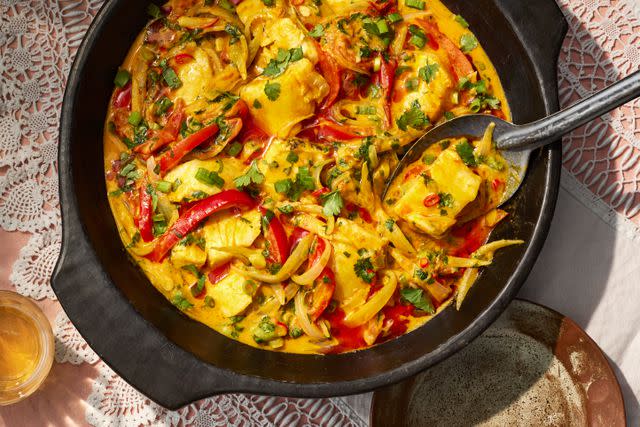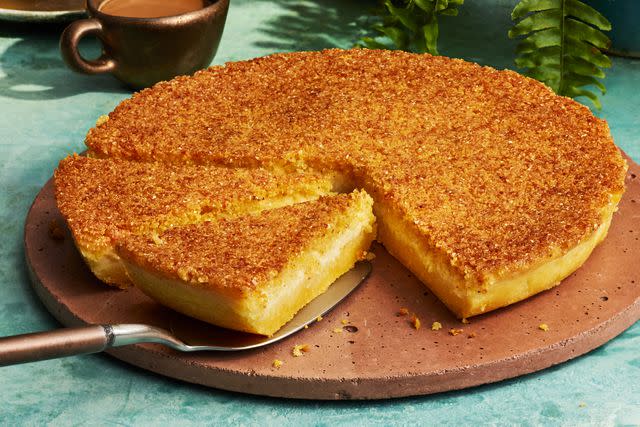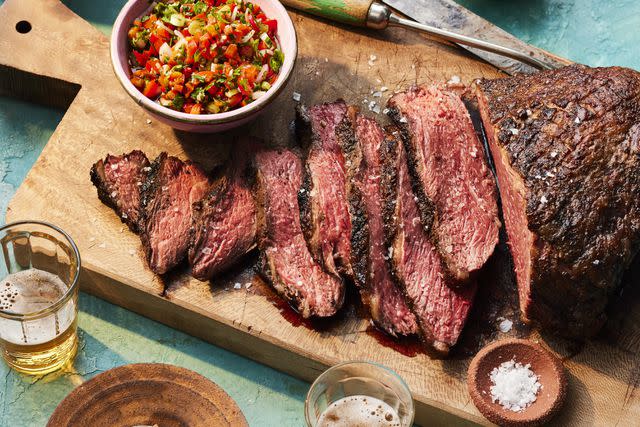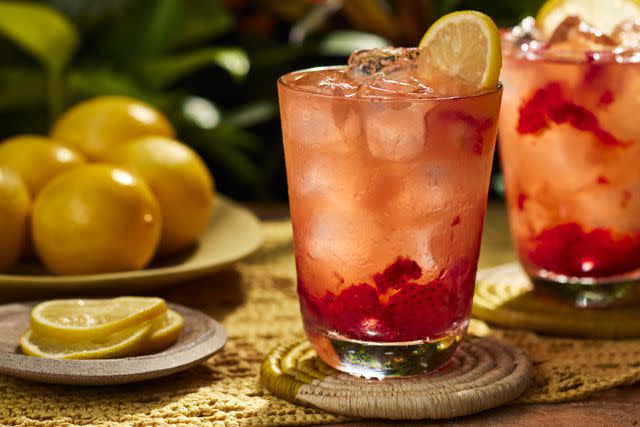A Brazilian Feast with Junior Borges
Chef Junior Borges celebrates his Afro-Brazilian heritage through the dishes of Bahia.
:max_bytes(150000):strip_icc():format(jpeg)/GRILLED-PICANHA-WITH-PIRI-PIRI-FT-MAG-RECIPE-0524-2df4eacecac4418e908f312ec7c0a783.jpg)
Victor Protasio / Food Styling by Margaret Dickey / Prop Styling by Claire Spollen
In the kitchen of his central Dallas home, chef Junior Borges reaches for a bottle of dendê oil. He adds a slow, generous pour of the crimson liquid, derived from African oil palms, to a pot of moqueca. As the iconic Brazilian fish stew simmers on the stovetop and the oil warms, a pungent smell fills the air, and Borges’ expression becomes visibly pleased. “If I’m trying to represent Brazil, I have to be true to the country,” he says. “To me, nothing represents my upbringing and my culture like moqueca.”
More than 20 years ago, Borges pioneered a classic yet expansive approach to Brazilian food in the United States, one that elevates the nation’s African history, and he’s kept to it ever since. As a result of the transatlantic slave trade, people of African descent make up more than half of Brazil’s population, and African influences are integral to and interwoven with Brazil’s national foodways: Across the country, African vegetables like yams and okra are mainstays in Brazilian kitchens.
Borges hails from Mimoso do Sul, north of Rio de Janeiro, but like many Afro-Brazilians, he has familial roots (through his grandmother) in Bahia, a coastal Brazilian state where about 80% of the population is Black or multiracial, and where many enslaved people were forced to work on sugar plantations during Portuguese colonization. Many of Bahia’s most beloved dishes can be traced directly to West Africa, such as acarajé, black-eyed-pea fritters stuffed with shrimp and spicy pastes, which are a direct descendant of West African akara. Bahia is also where moqueca — a dish that’s become synonymous with Brazilian cooking — is from, bubbling fiercely in time with the vibrant pulse of the country’s Black diaspora. Borges’ grandmother always served the stew with a side of farofa, the crunchy toasted cassava served alongside most meals. Today, Borges does the same with his own version. It’s part of an ongoing mission to honor his family and heritage while implementing elements of his experiences cooking around the world. “I started bridging those two things,” he says, “and trying to figure out, ‘How do I represent her, but also do my own take?’”
While growing up in Brazil, Borges explored Brazilian and French cuisines in Rio de Janeiro’s restaurants; those dishes, alongside the Bahian ones he enjoyed at home, formed the foundation of his culinary education. After moving to New York City in 1999, he began working in bars and restaurant kitchens and making weekly visits to the Union Square Barnes & Noble in order to read and study the cookbooks there. He eventually attended the French Culinary Institute and worked at a number of fine-dining restaurants in New York (including A Voce, under 2010 F&W Best New Chef Missy Robbins) before moving to Dallas in 2014, where he was the opening executive chef of the city’s outpost of Uchi. It’s in Dallas that Borges made his home and grew his culinary career, most recently at Meridian, where the menu centered Borges’ personal approach to Brazilian food.

Cedric Angeles
Borges leaps beyond the limited expectations that often bind Brazilian chefs to a career of cookie-cutter steakhouses, instead exalting Bahian, Brazilian, and global flavors. His picanha, a flavorful cut of beef popular in Brazil, satiated the hungriest of Texas meat lovers while he was at Meridian; here, he lashes the grilled roast with a zingy piri piri sauce. He sources local meats to reimagine feijoada and uses tapioca to give his pão de queijo, Brazil’s irresistible cheesy balls of bread, a chewier bite. Espetinhos de queijo de coalho, a snack of skewered cheese grilled over coals sold by vendors along the scenic coasts of Brazil’s beaches, is the inspiration for his Grilled Beach Cheese. For it, Borges channels his childhood memories into a blistered cheesy snack drizzled in a garlicky hot honey infused with Thai chiles and coriander. Brazilian foodways are Borges’ canvas for experimentation and evolution, which he tints with the various flavors and techniques he has amassed during his career.
Borges left Meridian late last year to start his own hospitality group, which he hopes will be a launching pad for his future Brazilian restaurant ventures. With it, he joins a small but growing number of Black Brazilian chefs who are feeling empowered by their heritage and eager to share another dimension of Black identity. There aren’t that many Afro-Brazilians in the United States, but those in the community find one another. And for Borges, as he considers his next venture, home and heritage remain at the forefront. In Dallas, this father of three tosses a dish towel over his shoulder and tests a spoonful of moqueca, then takes one for his young daughter Maia, who’s gesturing for a taste. The old and new flavors meld together harmoniously, reminding him that he is exactly where he needs to be.
Junior Borges' Brazilian Pantry
Cassava Flour
Known as farinha de mandioca, cassava flour is made from cassava (also known as yuca) that has been grated, pressed, dried, and ground into a flour. The flour is toasted with salt, spices, and, often, smoked meats to make farofa, a crumbly, crunchy flour resembling gently powdered breadcrumbs. Farofa is a ubiquitous side dish on kitchen and restaurant tables across Brazil. In Bahia, it’s not uncommon to taste farofa that’s been toasted with dendê oil, which gives it a deeper, somewhat nuttier flavor than other variations. A cousin of West Africa’s garri, which is also derived from cassava root, farofa is an essential part of Brazilian meals and is a satisfying, traditional match for substantial dishes, for instance atop or alongside meaty feijoada or moqueca (recipe p. 110).
Malagueta Chiles
The malagueta pepper, about two inches long and bearing a resemblance to the bird’s eye or Thai chile, is widely used in Brazil. While it is available fresh, most commonly it’s preserved—large jars of the crimson chiles are a regular sight in Brazil’s bars and restaurants. Borges always keeps a few jars of the peppers on hand to add to hearty stews and soups. “You can also use the brine, which has spice and acidity to it, for different dishes,” he says, noting that if you want a modest amount of heat, adding just a few drops of the brine to a dish does the trick.
Dendê Oil
Pungent, burnt-red-orange dendê oil animates practically every dish in Afro-Brazilian cuisine. The dendezeiro palm tree, native to Africa, bears a small fruit that produces the scarlet oil. Dendezeiro palms may have arrived in Brazil with enslaved Africans as early as the 1500s, according to some historians. What is known for sure is that by the 1600s, this palm oil was a key part of Bahia’s rapidly growing religious and culinary culture. It is considered a necessity for food prepared as offerings for orishas—Bahian religious deities—and equally essential for giving both body and depth to the region’s most celebrated fare, stippling moqueca and enlivening acarajé, seafood-stuffed black-eyed-pea fritters.
Cheese
With just one bite of Brazil’s heaven-sent cheese bread, pão de queijo, it’s easy to see why cheese is an important component of the country’s greatest culinary contributions. Borges has two constants in his kitchen: queijo coalho (literally “cheese curd”), a cheese with a springy, elastic texture that he uses for his fragrant and smoky grilled beach cheese, and catupiry, a creamy cheese with a smooth texture that’s the filling for pão de queijo, as well as pizzas, crêpes, and coxinhas, deep-fried Brazilian snacks often filled with chicken.
Tapioca
Tapioca is a naturally gluten-free starch that’s derived from the juice of pressed cassava. There are two main kinds: sweet tapioca flour (polvilho doce), a fine powder derived from fresh juice, and sour tapioca flour (polvilho azedo), made with juice that has been fermented to develop a tangy flavor. Borges uses sweet tapioca flour to make beiju de tapioca, light, fresh crêpes that the chef describes as “one of the most indigenous components of the cuisine.” Beiju de tapioca can be stuffed with fillings like chocolate, cheese, and even eggs—which Borges prepares for his daughter—and is a favorite easy meal across the Brazilian diaspora. It’s in the company of other favorite tapioca-based dishes, such as pão de queijo, which Borges makes with both sweet and sour tapioca.
Moqueca com Farofa de Dendê (Brazilian Fish Stew with Toasted Cassava and Dendê Oil)

Victor Protasio / Food Styling by Margaret Dickey / Prop Styling by Claire Spollen
For this Brazilian fish stew, Junior Borges builds flavor from the sauce by cooking aromatic vegetables, shrimp paste, and malagueta chiles in piquant and fragrant dendê oil. Rich coconut milk is added in, and sea bass is gently simmered for a comforting and hearty dinner. Bright red dendê oil is produced from the fruit of dendezeiro palm trees that were brought to Brazil from Africa. It brings pungent, sweet flavor to the dish. Borges likes to serve his moqueca traditionally — with farofa, a cassava meal that’s toasted in the pan with dendê oil. The fine, crumbly side dish is perfect for soaking up the saucy stew.
Bolo Cremoso de Milho (Creamy Corn Cake)

Victor Protasio / Food Styling by Margaret Dickey / Prop Styling by Claire Spollen
Junior Borges’ grandmother was a particularly adept baker, and Borges and his cousins were especially fond of her bolo cremoso de milho. The seven-ingredient skillet cake forms a creamy center surrounded by tender cornbread with a crunchy top. Make sure to use a well-seasoned cast-iron skillet to prevent the cake from sticking to the pan.
Grilled Picanha with Piri Piri

Victor Protasio / Food Styling by Margaret Dickey / Prop Styling by Claire Spollen
Junior Borges grills Brazil’s most famous beef cut, the ultra-flavorful picanha (or top sirloin cap), for a roast that’s juicy and tender. Borges serves his picanha with a piri piri sauce that features malagueta chiles — small but mighty peppers with bracing sweet heat. If you can’t source picanha, you can substitute tri-tip, another flavorful cut with nice marbling; it can be cooked the same way as the picanha, but it might be slightly tougher.
Meyer Lemon and Strawberry Caipirinha

Victor Protasio / Food Styling by Margaret Dickey / Prop Styling by Claire Spollen
The caipirinha wouldn’t exist without the millions of Africans who toiled under brutal conditions on the nation’s sugarcane farms to produce the foundation of cachaça, Brazil’s prized distilled spirit. Junior Borges adds Meyer lemon juice and muddled strawberries to this classic drink for a beautiful and refreshing cocktail.
For more Food & Wine news, make sure to sign up for our newsletter!
Read the original article on Food & Wine.

